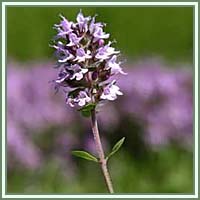WILD THYME
Thymus serpyllum
Common name: Wild Thyme
Latin name: Thymus serpyllum
Other names: Breckland Thyme, Creeping Thyme, Lemon Thyme
Family: Lamiaceae
Habitat: Wild Thyme is native Europe and North Africa. It prefers dry soils, and can be found alongside roads, on rocks and other infertile or deserted grounds.
Description: Wild Thyme is a prostrate subshrub growing to 2 cm tall. It woody and fibrous roots and has creeping, woody stems growing 10 cm long. Leaves are converse and slender, oval to oblong shaped. At the base, they are bordered with soft hairs. Flowering occurs from May to early June. Flowers are strongly scented, and vary in color: they are lilac, pink-purple, magenta or white. They are produced in clusters of three or four.
Parts used: Whole herb.
Medicinal use: Wild Thyme has a rich history of medicinal uses, and is very useful in treatment of various ailments. In folk medicine, the plant had been considered to have antiseptic, diuretic, sedative and expectorant properties. Most commonly, Wild Thyme is used either in form of an infusion or a syrup for a variety of respiratory problems and infections, such as flu, colds, sore throat, coughs, bronchitis, chest infections and sinusitis. Wild thyme also acts as an antispasmodic, and can be used to relieve pains from spasms and cramps. It is also very beneficial in treatment of mastitis, wounds, cuts and ulcers. Wild Thyme infusion is also effective in cases of flatulence, excessive gas and weak digestion. Wild Thyme tea is said to be useful in cases of headaches and nervous disorders.
Safety: Some herbs could interreact with certain medication. Therefore it is advisable to contact your doctor/herbalist before consumption of any herb.

